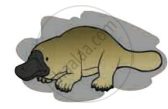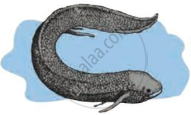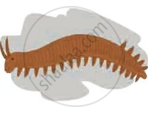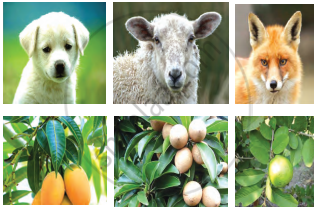Advertisements
Advertisements
प्रश्न
Write the answers to the questions by observing the figure below.
 |
 |
 |
| (a) | (b) | (c) |
- Write the name of the animal ‘(a)’ in the figure.
- Write the name of the animal ‘(b)’ in the figure.
- Write the name of the animal ‘(c)’ in the figure.
- Which evolutionary evidence is illustrated by this figure?
- Write the definition of that evidence for evolution.
उत्तर
- ‘(a)’ - Duck billed platypus
- ‘(b)’ - Lungfish
- ‘(c)’ - Peripatus
- The evolutionary evidence illustrated in the given figure is connecting links.
- Definition: Connecting links are some plants or animals that show morphological characters by which they can be related to two different groups of organisms.
संबंधित प्रश्न
Mammals : _________ : : Amphibia : Fishes
State the connecting links between Peripatus with Annelida and Arthopoda.
With the help of any two suitable examples explain the effect of anthropogenic actions on organic evolution.
Select two pairs from the following which exhibit divergent evolution. Give reasons for your answer.
(i) Forelimbs of cheetah and mammals
(ii) Flippers of dolphins and penguins
(iii) Wings of butterflies and birds
(iv) Forelimbs of whales and mammals
Explain with an example for the given, how the following provides evidence in favor of evolution in organisms :
Fossils
Name the scientists who Discovered the fossil of Australopithecus
Explain the evolution of giraffe's neck according to Lamarck's theory of evolution.
How do homologous organs help in providing evidence for organic evolution?
Differentiate between analogous and homologous structures.
The forelimbs of a frog, a bird and a man show the same basic design (or basic structure) of bones. What name is given to such organs?
Name two animals having homologous organs and two having analogous organs. Name these organs.
In a class, students were asked to observe the models/slides/pictures of the skeletons of forelimbs and wings of different organisms. After the observations the students made the following groups of homologous structures. Select the correct group :
(A) Wings of a bird and a butterfly
(B) Wings of a pigeon and a bat
(C) Wings of a butterfly and a bat
(D) Forelimbs of a cow, a duck and a lizard
You have potato, carrot, radish, sweet potato, tomato and ginger bought from the market in your jute bag. Identify two vegetables to represent the correct homologous structures.
(A) Potato and tomato
(B) Carrot and tomato
(C) Potato and sweet potato
(D) Carrot and radish
Complete the following chart:

Answer the following question:
What are homologous structures? Give an example. Is it necessary that homologous structures always have a common ancestor? Justify your answer.
Find an odd one out.
Give scientific reason.
Vertebrates have slowly originated from invertebrates.
Complete the flowchart.

Define the evidence of evolution shown in the figure.

Observe the given images and answer the following questions.

- Which evolutionary evidence does it indicate?
- What does it prove?
- State another example of evolutionary evidence.
Biogenetic law states that ______.
Select the CORRECT set of homologous organs.
The fossil remains of Archaeopteryx is a connecting link between ______
- Define vestigial organs.
- Write names of any two vestigial organs in the human body.
- Write name of those animals in which these vestigial organs are functional.
Why do all the gametes formed in human females have an X chromosome?
Palaeontological evidence for evolution refers to the ______.
Which of the following is used as an atmospheric pollution indicator?
Analogous organs arise due to ______.
Did aquatic life forms get fossilised? If, yes where do we come across such fossils?
How do we compute the age of a living tree?
Give an example for convergent evolution and identify the features towards which they are converging.
How do we compute the age of a fossil?
As shown in figure below some organisms that share a common ancestor have features that have different functions, but similar structures.

These are known as ______. Give example.
Write down the difference between homologous and analogous organs.
Explain natural selection with the example of industrial melanism.
Industrial melanism was highlighted by ______.
Pick the odd man out:
Write names of some vestigial organs in the human body.
